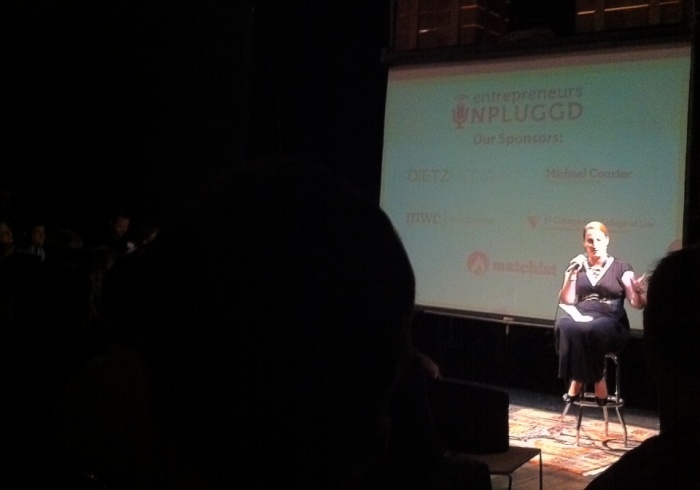
 Entrepreneurs Unplugged hosts intimate gatherings where entrepreneurs can learn valuable lessons from real world experiences. By keeping the crowd small and the venues cozy, hosts Stella Fayman and Tim Jahn encourage speakers to share personal details from their professional history.
Entrepreneurs Unplugged hosts intimate gatherings where entrepreneurs can learn valuable lessons from real world experiences. By keeping the crowd small and the venues cozy, hosts Stella Fayman and Tim Jahn encourage speakers to share personal details from their professional history.
On Tuesday night Entrepreneurs Unplugged invited the founders of SitterCity, Power2Switch and Belly to share their tips for building a disruptive startup. The three founders explained how they came up with their initial ideas, solved customer problems and built a successful company that breaks the rules of an outdated industry while truly disrupting the market.
Here are the nine steps they suggest to achieve similar disruptive startup success:
1. Get an idea
All great disruptive ideas come from something that pisses you off or inconveniences you. To turn this idea into a business you must dare to question the basic principles that are seemingly set in stone. To be a true disrupter you also need to be an inventor. “Combining various different models into something new that works leads to large scale disruption. SitterCity was essentially Match.com for parents and caregivers with a little bit on Monster.com thrown in,” said Genevieve Thiers, Co-Founder of SitterCity.
2. Identify and solve the problem
You don’t always have to build the future to be disruptive; you can improve on what is already there. “It’s not like I had some spark of genius–people tell me every single day I had this idea before you. It is not that innovate but it doesn’t matter because no one had done it,” said Logan LaHive, CEO and Founder of Belly. After nailing down the problem he wanted to solve, he set about bringing the idea to life. “I went straight to the source, talking to business owners and customers to find out their problems and what they care about,” LaHive said.
4. Be prepared to hear ‘No’
“If you want to do something a bit different you will have to stick to your guns. Passion will be the only thing that will get you through the early days when everyone is saying no,” said Seyi Fabode, Co-Founder and CEO of Power2Switch. Success means taking the role of an evangelist, spending time teaching those around you the benefits of your idea and working to build up a level of trust. Sometimes this must be done on an individual basis. “Most disrupters do not see any difference between marketing to whole groups of people and converting the one person that is currently in front of them,” Thiers added.
5. Sell to get traction
In order to build something you have to be able to sell, a skill LaHive deems under-valued in today’s marketplace. Selling leads to traction, which ultimately leads to funding. You don’t need a business or a marketing plan to sell your product: simply go to the source and find out what changes need to be made so they will buy your product. “Marketing and PR are just fluff unless someone will pay for what you are making,” LaHive said.
6. Secure capital fast
The minute you have a breakthrough you will be copied. To make sure a competitor doesn’t capitalize on your hard work as an inventor and evangelist you need to line up VC funding before this breakthrough happens. Because disruptive companies cannot initially live off what they make from customers you also need to have a healthy Internet monetization model. Thiers recommends having three unique revenue drivers because, just like the economy, the success of the individual models will reshuffle every 8-12 years. “SitterCity is a combination of subscription, lead generation and advertising,” she said.
7. Make values a priority
Expanding your team can bring a breadth of new ideas and increased focus to your company if you stay value-driven during the hiring process. “Find people who think differently but share your values,” Fabode said. In his experience, being clear about your values from the early days will serve you immensely. Hiring different people will help in crafting a diverse team, allowing you to put a unique spin on an outdated industry ripe for disruption.
8. Listen to negative customer reviews
You will see the future through the mouths of your customers and the more you listen to them the more you can help solve their problems. “Bad customers will always have better information for you. It’s the bad ones that you really want to try and understand—that’s where the insights will come from,” Fabode said. All customers have a need and it’s your job to find a way to fill it. By engaging with your customers, building trust and choosing to work with companies that you believe will provide customers with good value is key when building a successful startup.
9. Be constantly disrupting
“If you are a true disrupter you are constantly disrupting your own disruption,” Thiers said. By nature, disruption has to come from an outside source. Because of this, more and more companies are creating their own competition, a reality that is sure to boost the growth of outdated industry.

